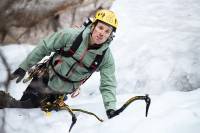Ed Viesturs Weighs In: When Does a Summit Count?
Did you summit? It’s a simple question with a complicated answer.
The summit of a mountain is its topmost level attainable, the peak, the highest point. Simple, right? Not so fast.
I’ve always believed climbing a mountain has to be a round trip. The second half of any climb, the descent, is the most important part of the actual event.
If you don’t have the strength, endurance, desire, or motivation to descend the entire way from the summit, back to base camp, then perhaps you should rethink your reasons for climbing or your system of training for such an endurance event.
Getting to the top is optional; getting down is mandatory. Climbers must plan their descent, whether it’s their return or their exit strategy, even before planning the ascent. The latter depends on the former.
Prioritize safety over success. Prepare yourself physically before a climb for a long-term, demanding event, and you’ll be faster and stronger — and therefore safer.
The Issue: Non-Emergency ‘Rescue’ Flights
Being flown off of a mountain for non-medical reasons before reaching base camp seems to cheapen the process and experience. Let the rescue choppers do what they’re there to do — rescue climbers that have real emergencies.
Other climbers are concerned the climbing process is being diluted. Nirmal “Nims” Purja, a world-famous high-altitude climber and member of Global Rescue’s Mountain Advisory Council, broke more records during the 2022 Himalayas spring climbing season. The Nepali mountaineer has a firm belief in summit etiquette.

“When I do a summit push, it is from base camp to the summit and then from the summit back to base camp,” Purja said.
“For me, that’s the only way to do it. It has to be authentic — no helicopter lifts back to base camp — unless the summit is void or there’s an emergency situation or rescue, and someone needs a helicopter.”
Kristin Harila, a newcomer to mountaineering who is attempting to beat Purja’s speed climbing record, said an authentic summit means returning to base camp without a helicopter evacuation “in principle, but you should not hesitate to be evacuated by helicopter if you are in trouble after summiting.”
“My journeys in the mountains start and end at base camp,” said Tom Livingstone, an acclaimed outdoor writer and climber. “I climb with the intention of staying safe and not needing a helicopter rescue. I don’t believe an ascent is valid if a helicopter is used whilst in the mountains — and an ascent must finish with the whole team safely back at base camp,” he said.
The issue of some mountaineers, perhaps with less experience or training, becoming more reliant on chopper rescues was noted as early as 2012 by Nick Heil. He wrote that mountaineers “worry that the presence of [rescue helicopters] alters expedition decision-making and encourages climbers to push beyond their limits.”

Conrad Anker, who summited Mount Everest twice, said, “The old-school thing was, you were self-sufficient. If an accident did happen, you would have the wherewithal to extract yourself and your teammates.”
Recently, a New York Times article reported a mountaineering medical doctor called in a false report of hypothermia after attempting and failing to summit Denali, the tallest peak in North America. He did this so he could be “rescued” by helicopter instead of descending on his own, according to a criminal complaint filed in Fairbanks, Alaska, federal court.
Gordon Janow, who has led expeditions to each of the highest mountains on the seven traditional continents and is the director of programs for Alpine Ascents, said that “turning around early before a medical emergency arises is just smart mountaineering.”
Mountaineering Has Inherent Risks — Accept Them
Climbing expert Alan Arnette says the mountaineering situation is changing, and not necessarily for the best.
“High-altitude mountaineering has always had risks. Climbers can mitigate these risks by arriving at their expedition well-prepared and self-sufficient as possible. Yet, in today’s environment, climbers are often told if they get in trouble, their rescue insurance will cover an evacuation off the mountain. This false sense of security is dangerous. Telling someone what they want to hear is never acceptable,” he said.
Arnette is a mountaineer who summited Mount Everest in 2011 and became the oldest American to summit K2 in 2014. He’s one of the world’s most respected chroniclers of mountaineering, according to Outside Magazine.
At the end of the day, it’s kind of lame to call in a chopper halfway down a mountain when you’re not seriously injured or ill, simply to avoid the last part of the descent. There have been numerous cases recently where climbers fake an illness or demand to be flown off just to get home sooner. It seems that being able to talk about your summit is more important than embracing the process.
The post Ed Viesturs Weighs In: When Does a Summit Count? appeared first on GearJunkie.

